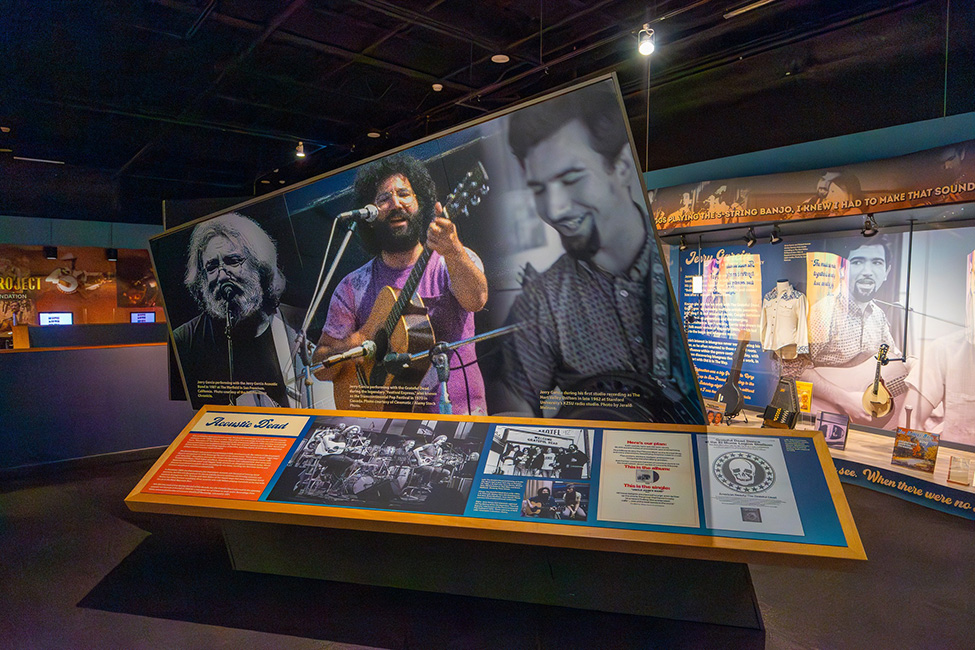
This report on the new temporary exhibit at the Bluegrass Music Hall of Fame & Museum, Jerry Garcia – A Bluegrass Journey, is a contribution from Steve Levine, a life long concert photographer and writer in Austin, TX.
Nicknamed “Captain Trips,” the leader of the most far-out, most psychedelic rock-and-roll band of them all is the subject of a new, two-year exhibit at the Bluegrass Music Hall of Fame and Museum in Owensboro, Kentucky.
A contradiction? Not at all.
Jerry Garcia’s career before, within, and without the Grateful Dead – and his impact on generations of bluegrass musicians and fans – won him the honor.
“Be it with his freewheeling improvisations or the immense contributions he made to the bluegrass repertoire, he continues to be a bluegrass influence today,” said Vince Herman of Leftover Salmon, who performed and orchestrated the exhibit’s opening weekend. “Long live the Gar!”
Or as guitarist Peter Rowan said in the movie, Bill Monroe: Father of Bluegrass Music, “The real psychedelic experience was in bluegrass music in that it had so many counter rhythms.”
Years before the Dead became the house band for Ken Kesey’s infamous “acid tests,” Garcia was a jug band banjo player who obsessively practiced Earl Scruggs’ rolling, three-finger picking style.
“I was attracted by the intensity of it, really,” Garcia told his biographer, Blair Jackson. “And I was drawn to the incredible clarity – when something is going along real fast and every note is absolutely clear.”
But Garcia sought something more than he was finding in San Francisco’s tiny bluegrass scene. In the spring of 1964, he and Black Mountain Boys guitarist Sandy Rothman set off on a research road trip to the promised land. They shoved a big Wollensak reel-to-reel tape player in the back of Garcia’s 1962 Chevy Corvair and took off for places like Bill Monroe’s Bean Blossom music park in southern Indiana. They jammed wherever they found like-minded players, and recorded idols like the McReynolds Brothers. They saw Monroe in concert several times, but never got up the nerve to ask the master for a job in his band. They met a hot young bluegrass mandolist named David Grisman at a Blue Grass Boys show at Sunset Park in Pennsylvania.
After they returned home, Rothman set off on tour with the Blue Grass Boys, and Garcia concluded he’d never be able to build a successful band from the West Coast’s bluegrass talent. The rise of the Beatles, Rolling Stones, and Bob Dylan’s electric music pulled many San Francisco folk and bluegrass musicians toward rock. Garcia swapped his banjo for the electric guitar. He dropped a lot of acid and launched the Grateful Dead – the raucous, spacy, dance band that became face of the Haight-Ashbury hippie culture in the Summer of Love.
But Jerry Garcia didn’t put down the five string for good, and that’s why he he’s in Owensboro today. He laid down some banjo tracks on two Grateful Dead recordings. The first, in the late ’60s, was just a few rapid notes at the close of a single-length version of Dark Star, their jammiest of jam tunes. The second came a few years later with a bouncy banjo track on Cumberland Blues, a classic miner’s lament, and the closest the Dead ever came to a bluegrass number.
Garcia told biographer Blair Jackson that he wrote Cumberland Blues as one part Bakersfield country-western and one part bluegrass. “That’s what I wanted to do,” he said, “A marriage of those styles.”
Dead lore has it that Garcia was so enamored with his banjo reunion he yearned for more. He fulfilled that wish with a side project he began in 1973 called Old and in the Way. The band featured Garcia on banjo, his old friend David Grisman on mandolin, Peter Rowan on guitar, Vassar Clements on fiddle, and John Kahn on bass.
“Playing with Old and in the Way was like playing in the bluegrass band I’d always wanted to be in,” Garcia says in the biography Blair Jackson wrote. “It was such a great band, and I was flattered to be in such fast company.”
The repertoire consisted of much of the traditional bluegrass music Garcia had long worshipped: Bill Monroe, the Stanley Brothers, Jim & Jesse. They also played some originals, like Rowan’s reefer tune, Panama Red, and even oldies like The Great Pretender.
The band played club gigs across the country for several years – including one at the Boarding House in San Francisco that was recorded and released as what was to become the group’s only album. It was well received. It also made history.
“The album is not only an utterly delightful series of musical performances, but also one of the very best recordings I have heard in a long time,” longtime San Francisco Chronicle music critic Ralph Gleason wrote shortly after the record’s release.
Garcia’s legions of worshipping fans famously followed him and the Dead from coast to coast to see show after show after show. Many of them followed him into bluegrass as well. Dead fans ate up the Old and in the Way album, helping to fuel the bluegrass expansion into mainstream American culture.
As Ronnie McCoury says, “I tell audiences I found the Grateful Dead through Old and in the Way, and many of the crowd found bluegrass from Old and in the Way.”
According to legend (and the internet), Old and In the Way was the best-selling bluegrass album ever, until the soundtrack for O Brother, Where Art Thou? knocked it off the throne in 2000. Surprisingly, for an industry that counts everything and awards gold and platinum records only after meticulous documentation, no current source has any hard sales numbers to back up the legend. Skeptics can probably rely on what this publication wrote a decade ago when it called the album “one of the best-selling bluegrass records of all time.”
In the final years of his life, Garcia rekindled his friendship and musical relationship with Grisman. The two spent hundreds of hours jamming in Grisman’s Dawg Studios, often with Jim Kerwin on bass and Joe Craven on violin and percussion. Garcia played acoustic guitar – not the banjo – in these sessions; Grisman was on mandolin.
The tape was rolling whenever they hit the studio, and Grisman released seven albums from the sessions. Not for Kids Only, one of two that came out while Garcia was still alive, contained 12 tracks of children’s songs from the New Lost City Ramblers Songbook. In recordings and rare live appearances, Garcia and Grisman introduced a new generation of musicians to genre-busting possibilities.
“We were both very eclectic, and didn’t view music as anything closed,” Grisman said in a 2001 billboard interview at the release of the video, Grateful Dawg. “We weren’t there just to play bluegrass music, or just to do folk songs, or kids songs, or jazz instrumentals. I mean, we were there to do anything that came into our minds. And Jerry was a guy who was up for that.”
The marriage of Deadheads and bluegrass fans spawned the jamgrass movement. The firstborn, like Leftover Salmon, Railroad Earth, and Greensky Bluegrass, came around not long after Garcia’s death in 1995. They toured ferociously and started festivals like Yarmony Grass and Hillberry. They prepared the way for Billy Strings, the guitar wiz who is selling out 20,000-seat arenas playing bluegrass, Americana, and Dead tunes.
“I knew about bluegrass first,” Strings says in a video about the exhibit. “Then I learned about David Grisman, and that led me to Jerry Garcia and the Grateful Dead.”
That’s a common path for many bluegrass artists, who now celebrate Garcia’s enduring influence on their craft. “I found Jerry Garcia and the Grateful Dead through the music of my mentor, David Grisman,” said Ronnie McCoury, who said he was honored to help launch the new exhibit.
“Their playing together is very influential on me, and I’ve dug deep into it for the last 30 years or so. Garcia’s impact on bluegrass is truly impactful, and I’m very proud to be a part of helping to carry Garcia’s legacy forward.”



About the exhibit:
According to the Bluegrass Hall of Fame, “Jerry Garcia: A Bluegrass Journey will occupy 2,000 square feet and include artifacts, interactives, exclusive interview content, and more. … The exhibition explores Garcia’s early years as a banjo player, his deep connection to bluegrass, and the influence it had on his legendary career.“
The exhibit opened in March with three days of live music, documentary screenings, and panel discussions.
The Bluegrass Hall of Fame and Museum, at 311 W 2nd St. in Owensboro, is open Tuesdays through Sundays and closed on Mondays. Tickets, which include access to the Garcia exhibit, are $14 for adults.







